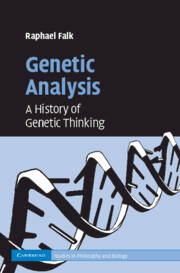Book contents
- Frontmatter
- Contents
- List of figures
- Acknowledgments
- Introduction
- PART I FROM REPRODUCTION AND GENERATION TO HEREDITY
- PART II FAKTOREN IN SEARCH OF MEANING
- PART III THE CHROMOSOME THEORY OF INHERITANCE
- 5 Chromosomes and Mendelian Faktoren
- 6 Mapping the chromosomes
- 7 Cytogenetic analysis of the chromosomes
- PART IV GENES AS THE ATOMS OF HEREDITY
- PART V INCREASING RESOLVING POWER
- PART VI DEDUCING GENES FROM TRAITS, INDUCING TRAITS FROM GENES
- PART VII WHAT IS TRUE FOR E. COLI IS NOT TRUE FOR THE ELEPHANT
- Concluding comments
- Bibliography
- Index
7 - Cytogenetic analysis of the chromosomes
Published online by Cambridge University Press: 07 August 2009
- Frontmatter
- Contents
- List of figures
- Acknowledgments
- Introduction
- PART I FROM REPRODUCTION AND GENERATION TO HEREDITY
- PART II FAKTOREN IN SEARCH OF MEANING
- PART III THE CHROMOSOME THEORY OF INHERITANCE
- 5 Chromosomes and Mendelian Faktoren
- 6 Mapping the chromosomes
- 7 Cytogenetic analysis of the chromosomes
- PART IV GENES AS THE ATOMS OF HEREDITY
- PART V INCREASING RESOLVING POWER
- PART VI DEDUCING GENES FROM TRAITS, INDUCING TRAITS FROM GENES
- PART VII WHAT IS TRUE FOR E. COLI IS NOT TRUE FOR THE ELEPHANT
- Concluding comments
- Bibliography
- Index
Summary
The chromosome theory of heredity made the chromosomes, their structure, and their functions major targets of genetic analysis. In 1916 Bridges showed how genetic analysis of exceptional aneuploids (organisms or cells that carry an unbalanced number of chromosomes) also provided analytic tools to gain insight into the mechanism of chromosome pairing and recombination, and into the limited role of the Y-chromosome in development. The part chromosomes play in development was also demonstrated by Blakeslee's trisomics in a study on the Jimson Weed (Chapter 5), and by the studies of Lewis J. Stadler and his students Barbara McClintock and Marcus M. Rhoades, who elaborated on the cytology of maize chromosome aberrations and their phenotypic correlates. Once the efficiency of X-rays in inducing aberrations was demonstrated and genetic experiments were designed to isolate proper chromosome constellations, cytogenetic analysis became a central tool for research, especially in those organisms whose chromosomes were large enough or otherwise easy to observe.
EUPLOIDY AND SEX DETERMINATION
Boveri's studies of the development of aneuploid sea urchin embryos indicated the importance of a complete and balanced set of chromosomes for development (Chapter 5). The importance of a complete and balanced set of chromosomes was also demonstrated by the normal development of triploid zygotes of organisms that are otherwise diploid, such as triploid Drosophila females.
Many plant species can be shown to be ploidly-related to each other. This is especially significant in cultivated plants, where over the millennia breeders selected (or produced) polyploids.
- Type
- Chapter
- Information
- Genetic AnalysisA History of Genetic Thinking, pp. 108 - 124Publisher: Cambridge University PressPrint publication year: 2009



